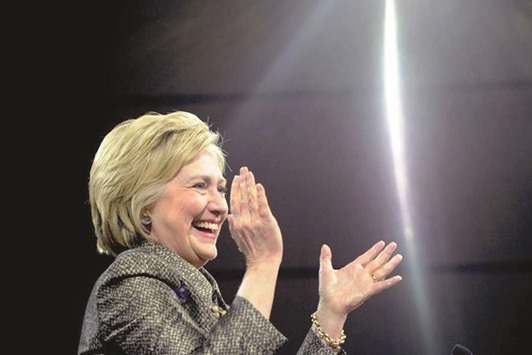Selina Meyer was the president on Veep. On Scandal, Mellie Grant is a nominee for president. On Madam Secretary, Secretary of State Elizabeth McCord has been offered the vice presidency — and has already temporarily served as president during a crisis. On House of Cards, Claire Underwood is the running mate of her incumbent president husband, Frank — and it would surprise no-one if she later elbowed him out of the way to become chief executive.
It would be easy to say that popular culture is just beginning to pick up on what is happening in the real political world. In fact, pop culture has been ahead of the population when it comes to a woman in the White House, and deciding which party she’d be from.
Serena Elavia, writing in The Atlantic last year, argued that TV’s female presidents have not included an “obvious Democrat.” They have been either ambiguous (Meyer, McCord) to avoid getting caught up in party-specific politics, or tilted Republican (Allison Taylor on 24, Sally Langston’s temporarily holding the office on Scandal).
One producer told Elavia, “a Republican female president adds an element of unpredictability.” The short-lived series Commander in Chief even tried to heighten that unpredictability with a president who had run on the Republican ticket but was politically independent.
And where did this all begin? By most accounts, the earliest example of a woman president onscreen was in the science-fiction movie Project Moonbase in 1953. Set in 1970, the movie features actress Ernestine Barrier as a character listed only as Madame President.
In 1964, moviegoers had a chance to see Polly Bergen as newly inaugurated President Leslie McCloud in the comedy Kisses for My President. Most moviegoers declined. An article for Turner Classic Movies argues that “all the jokes couldn’t disguise the fact that a still shell-shocked nation was in no mood to laugh about the presidency,” since the movie premiered less than a year after the assassination of John F. Kennedy.
But it’s also an awful movie, especially when viewed today. It’s far more interested in the president’s husband, Thad (Fred MacMurray), than the president herself.
We see Thad surprised by the feminine furniture usually assigned the first lady, distressed when the nation’s business interrupts his canoodling with his wife, and irked that after a successful business career he’s now facing at least four years of being “an absolute nothing.” Yet, after some bumbling, he’s the movie’s hero, stopping a scandal-mongering senator trying to bring down the president.
Kisses ends with Leslie resigning from office after she discovers she’s pregnant — since doctors insist she can’t run the country while being so. Thad smugly notes that 40 million women elected Leslie, but it took only one man to get her out of office.
As Judith B. Walzer wrote in Dissent, the film “seems to have been made in the dark ages of American political culture. Its approach is to show that the ridiculous consequences of electing a woman president make the whole notion impossible.”
It doesn’t even treat Leslie as much of a politician, with Thad summing up her credentials as “daughter of an ambassador, niece of a senator, former judge, wife, mother and a graduate of Radcliffe.”
That said, New York Times critic Bosley Crowther made what could look like a prescient comment if Clinton does become president: “We hope that the first woman to become president brings along a more amusing husband than Mr. MacMurray.”
The ensuing decades saw the idea of a woman president becoming more plausible; Shirley Chisholm ran for the Democratic nomination in 1972, and Geraldine Ferraro was presidential candidate Walter Mondale’s running mate in 1984. Neither campaign was successful, and a woman president was played for laughs again in 1985 when ABC presented the comedy Hail to the Chief, with Patty Duke in the White House. From Susan Harris, who had created the outrageous comedy Soap, the series featured “a cabinet of crazies,” says The Complete Directory to Prime Time Network and Cable TV Shows, and such crises as the president’s husband being “unable to make love.” It lasted seven episodes.
That wasn’t the end of presidential comedy; the 1998 gangster-movie parody Mafia! (sometimes called Jane Austen’s Mafia!) included a president played by Christina Applegate. But other works tried to show formidable women in the White House.
And at times scary women. For example, on Fox’s Prison Break, which premiered in 2005, vice president Caroline Reynolds (Patricia Wettig) is hip-deep in conspiracies, takes the top office after poisoning the president and appears to have had an affair with her brother.
A less melodramatic effort was the ABC drama Commander in Chief, premiering a month after Prison Break, starring Geena Davis as President Mackenzie Allen, a veep elevated to the top spot after the death of the president. (Polly Bergen, by the way, played Allen’s mother.)
But the show went through several off-camera production changes, none of which worked. The show proved “cartoonish and heavy-handed,” says The Complete Directory, while Walzer wondered if the show’s message was “it is too difficult for a woman to be president.”
Fox’s thriller 24, at times credited with making audiences more comfortable with the idea of an African-American president, introduced a woman president, Allison Taylor, in 2008. The TV movie 24: Redemption, which bridged the sixth and seventh seasons of the Kiefer Sutherland drama, included Taylor’s inauguration; the telecast premiered a few weeks after the election of Barack Obama, who had duelled Clinton for the Democratic nomination earlier in the year.
Played by Cherry Jones, Taylor was smart and tough, attacking “apathy, greed and fear” and ready to stare down terrorists. When she returned for the next full season of 24 in 2009, she was pressing on even after the death of her son.
More recently, besides the productions already mentioned, we had Sela Ward playing a hard-bitten but far from competent president in Independence Day: Resurgence. On TV, NBC’s State of Affairs had Alfre Woodard as the first black woman to become president. She was not the main character — that was a CIA analyst played by Katherine Heigl — and the generally silly show lasted a mere 13 episodes.
But it was more evidence that, regardless of what happens in the election in November, TV and movies have long since been ready for a woman in the White House. And they will probably look for more. —Akron Beacon Journal (Akron, Ohio)/TNS


